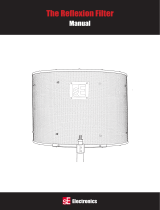
INPUT OUTPUT
24
21
3
+
XLR-3
5 Connecting the SZI 1015-T to the mains
The SZI 1015-T is powered via an external mains unit (e.g. NT 1015). Connect the DC cable of
the mains unit to terminal (DC input) of the SZI 1015-T. First cut off the co-axial DC connector
and prepare the cable by stripping off a 10 mm length of the plastic covering. Twist the wires and
insert into the correct slots in the barrier strip. It is vital that correct polarity is maintained; the
ribbed cable is connected to negative (–) and the other to positive (+). The mains unit can
supply an additional SZI 1015 radiator via terminal (DC output).
6 Connecting the audio source
Connect the output of your audio source (for example a mixing console) to the XLR-3 audio input
socket of the SZI 1015-T. Please use a standard XLR-3 cable of the required length.
If you wish to connect the K6 microphone system directly to the SZI 1015-T, a small modification
is required to the input amplifier – please contact your local Sennheiser agent.
The SZI 1015-T modulator/radiator is switched on by the incoming audio signal. It will send an
RF carrier signal to any connected radiators to switch them on, too. If no audio signal is present,
all radiators will be switched off after about 10 minutes.
7 Connecting additional radiators
If you want to use additional radiators to increase coverage, they have to be daisy-chained. Connect
the RF output socket of your SZI 1015-T to the RF input socket of the following SZI 1015 or
SZI 1029 radiator. A maximum of 100 radiators can be connected in series. The total RF cable
length should not exceed 1,500 metres. Please also read the radiator manual.
Alternatively, you can use the barrier strip to connect additional radiators. Use co-axial cable
without connectors to link the RF output terminal of the SZI 1015-T to the RF input terminal
RF IN of the subsequent SZI 1015 radiator. For connection, remove approx. 20 mm of the cable
sheath and twist the braiding. Strip the neutral conductor by about 10 mm. The twisted braiding
is inserted into the earth terminal, the neutral conductor into the terminal on the right of the earth
terminal. An NT 1015 mains unit can supply one SZI 1015-T modulator/radiator plus one SZI 1015
slave radiator.
When the last radiator has been connected, the IR transmission system can be put into operation.
AF

















